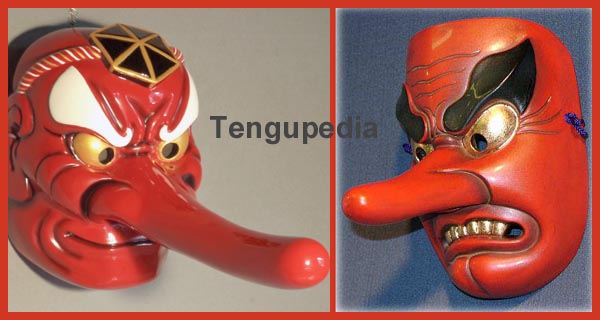. Tengupedia - 天狗ペディア - Tengu ABC-Index .
:::::::::::::::::::::::::::::::::::::::::::::::::::::::::::::::::::::::::::::::::::::::::::::::::::::::::::::::::::::::::::::::::::::::::::::::::::::::::::::::::::::::::::::::::::
ukiyo-e 浮世絵 Ukiyo-E with Tengu
. Join the Ukiyo-E friends on facebook ! .

:::::::::::::::::::::::::::::::::::::::::::::::::::::::::::::::::::::::::::::::::::::::::::::::::::::::::::::::::::::::::::::::::::::::::::::::::::::::::::::::::::::::::::::::::::
. Kawanabe Kyosai 河鍋暁斎 (1831 - 1889) .

source : dassai2.p2.weblife.me
Tengu and an Elephant pulling a rope with their long noses.
象の鼻引

source : 骨董山策日誌
Hiten to Tengu 飛天と天狗 Apsara and Tengu
. hiten 飛天 Apsara, Apsaras, Heavenly Maidens .

source : mag jaapan pinterest
Long noses yokai - Ashinaga-Tenaga + Tengu
. Akibayama 秋葉山 Akiba Yama Karasu Tengu .
. koboozu hitori tengu hachinin 小坊主ひとり天狗八人 .
. . . CLICK here for more pictures by Kyosai !
:::::::::::::::::::::::::::::::::::::::::::::::::::::::::::::::::::::::::::::::::::::::::::::::::::::::::::::::::::::::::::::::::::::::::::::::::::::::::::::::::::::::::::::::::::
Utagawa Kunisada 歌川国定

- quote -
Hell is empty and all the devils are here
The woodcut print by Kunisada Utagawa above features six Japanese masks.
..... This Kunisada print is particularly interesting as it features pop-up flaps on strings attached to the lower half of the six masks. Pulling on them reveals gaping mouths. In this way these masks are reminiscent of traditional 舞楽 bugaku masks.
..... Kunisada’s work features some of the most notoriously terrifying creatures of Japanese folklore. The third red mask from the left is identified as a type of oni-no-men (鬼ノ面) by the Japanese script on its right. In folkloric tradition, oni (鬼) are a type of yōkai (妖怪), which is the name given to supernatural creatures. The men in the term oni-men is translated to mean ‘mask’. Oni are generally thought to be hideous, horned, ogre-like creatures with large talons. Their skin is most typically red or blue. Oni were believed to cause disasters, disease and other forms of misfortune. They were also thought to devour humans.
The red mask on the far right is a hanataka-men (鼻高面).
It represents the hanataka-tengu (鼻高天狗). Tengu literally means “heavenly dog”, as the creatures take their name from a legendary Chinese demon dog. However in Japanese culture, tengu is a deceitful and malicious yōkai originally thought to take on the form of a bird of prey. Over the years, however, many different forms of tengu have arisen. The one featured in Kunisada’s print is a hanataka-tengu, which can be understood as “long-nose tengu”. The long-nose tengu is identified by its abnormally long nose and red face, resembling closely the Western goblin. It has been depicted bewitching people and put them into a trance.
On the left of the hanataka-men is the hannya-men (般若面). The hannya (般若) mask is commonly used in Noh theatre (a classical form of Japanese musical drama) and typically represents a jealous female demon. In Noh, hannya is a woman who has become possessed by her jealousy and obsession and she typically has two horns and a leering mouth. Nuances of human emotion are a characteristic feature of Noh theatre. The hannya displays this subtlety as it is meant to evoke both demonic and sorrowful qualities. When the actor wearing the mask looking straight ahead at the audience , the mask appears terrifying, but when he looks down, the masks paints a picture of torment, as the character appears to be crying. .....

and a photo of People Bewitched by a Tengu (Japanese mountain demon)
Colour woodcut attributed to Kyōsai Kawanabe
- source : Gillian Daniel -
:::::::::::::::::::::::::::::::::::::::::::::::::::::::::::::::::::::::::::::::::::::::::::::::::::::::::::::::::::::::::::::::::::::::::::::::::::::::::::::::::::::::::::::::::::

. - - - Join my Tengupedia friends on facebook ! - - - .
:::::::::::::::::::::::::::::::::::::::::::::::::::::::::::::::::::::::::::::::::::::::::::::::::::::::::::::::::::::::::::::::::::::::::::::::::::::::::::::::::::::::::::::::::::
. Tengu 天狗と伝説 Tengu legends "Long-nosed Goblin" .
. - yookai, yōkai 妖怪 Yokai monsters - .
. Legends and Tales from Japan 伝説 - Introduction .
. Mingei 民芸 Regional Folk Art from Japan .
- #ukiyoe -
:::::::::::::::::::::::::::::::::::::::::::::::::::::::::::::::::::::::::::::::::::::::::::::::::::::::::::::::::::::::::::::::::::::::::::::::::::::::::::::::::::::::::::::::::::
[ . BACK to DARUMA MUSEUM TOP . ]
[ . BACK to WORLDKIGO . TOP . ]
:::::::::::::::::::::::::::::::::::::::::::::::::::::::::::::::::::::::::::::::::::::::::::::::::::::::::::::::::::::::::::::::::::::::::::::::::::::::::::::::::::::::::::::::::::
No comments:
Post a Comment